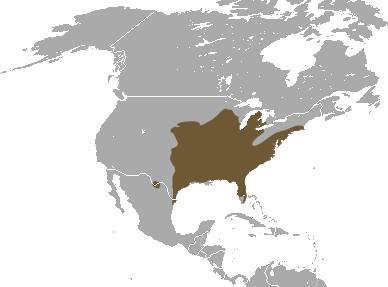Eastern Moles
Scalopus aquaticus
English: Eastern Mole (Scalopus aquaticus) range (Photo credit: Wikipedia)
Eastern Mole
Scalopus aquaticus
The Eastern Mole searches for favorable habitat in forests, nature areas and open fields, generally with moist earth and soft soil. However, they don't like ground with too much water and prone to flood. As their name states, they are mostly found in the East coast of the U.S.
They can be identified from other mole species based on their hair body fur coat, which has unique colors compared to other moles. They usually have brownish gray coat on the top parts of their body, with lighter shade as the fur goes down their underside. They don't have long tail, and barely have any hair. A similar trait they share with other moles are their scooping long claws, which helps them dig burrows and tunnels. The life expectancy of this species is around 5 to 7 years.
During winter, they tend to dig deep underground for their tunnels to stay as warmth as possible, far from the freezing cold temperatures in the surface. When it rains, they become more active as the water drives the worms, larvae and other soil invertebrates into the mole's burrows.
These moles are widely distributed in the eastern parts of the United States. Some of the states which have documented appearances of moles are Maryland, Kentucky, Ohio, Massachusetts, North Carolina, Wisconsin, Kansas, Connecticut, Texas, Pennsylvania, Virginia, Florida, Alabama, Tennessee, Indiana, Arkansas, Minnesota, New Hampshire, Nebraska, Oklahoma, Missouri, Louisiana, Illinois, Michigan, Iowa, Mississippi, Georgia, South Carolina, West Virginia, Rhode Island, and New York.
The Eastern Mole consume almost the same food sources like other major mole species. They dig tunnels on spots where they smell a lot of earth invertebrates like slugs, sow bugs, snails, centipedes and earthworms. Some plants and seeds can also consumed if they can't find any insects in the earth. If the invertebrates has been exhausted or there's not much prey to hunt upon, the mole leave and look for another place.
 English: A photograph of Scalopus aquaticus. The eastern American mole (Scalopus aquaticus linnacus) showing the large forelimbs used to excavate tunnels. (Photo credit: Wikipedia)
English: A photograph of Scalopus aquaticus. The eastern American mole (Scalopus aquaticus linnacus) showing the large forelimbs used to excavate tunnels. (Photo credit: Wikipedia)
This wildlife species can work either at night or day, with frantic activity around dusk. Their tunnel systems consists of two kinds, with the deep tunnels for nest, food cache, mating and resting area. The shallow burrows are often used as a catch basin for the larvae, snails, beetles, worms, mites or other food invertebrates.
The Eastern Mole have the ability to reproduce three to 5 baby moles, with gestation from 42 to 46 days. They look for mates and breed sometime early February up to March. The female mole gives birth around April to June. The young moles usually mature quick, which then leave their parent's nest after 30 to 32 days. These moles look for new territory to live on their own.
The moles usually grow 5.50 to 5.80 inches, including the body and head. They have their tails at length from 1.20 inches to 1.40 inches. The Eastern Moles have an extraordinarily long snout. Their average weight can be around 3.20 to 3.45 oz.
These wildlife animals can cause damages in golf course facilities, back yards, fields, estate lawns and farms. Since moles are insectivores, they may disrupt the ecological balance of insects on the earth. They may also uproot flower buds, roots, crops and plants.
Most people consider moles as garden pests because of the damages they cause outdoors. This wildlife digging animal can be regulated or controlled by mole trappers and other wildlife removal procedures. You can contact a wildlife company so they can determine the best methods to remove the moles. Wildlife professionals have the permits and licenses in handling wildlife animals.

